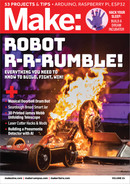
PROJECTS: Amateur Scientist
discussed forming a company to sell
electronic kits. When I showed Ed the light
flasher article, he agreed it could become our
first project. We recruited Bob Zaller and Stan
Cagle and formed Micro Instrumentation and
Telemetry Systems (MITS).
MITS sold only a few hundred light flashers
and model rocket transmitters, so we moved
to a series of other projects, including a diode
laser I designed and the Opticom light-wave
communicator Ed and I designed. Popular
Electronics published the Opticom project as
a cover story. When I left the Air Force and
MITS in 1970 to become a full-time writer, I
wrote manuals for calculators Ed designed at
MITS. In 1974, Ed developed the Altair 8800
hobby computer kit. He gave me one of the
first assembled Altairs in return for writing the
manual. (See my column in Make: Volume 42,
“The Kit That Launched the Tech Revolution,”
makezine.com/2015/01/08/the-kit-that-
launched-the-tech-revolution.)
The Altair project became the cover article
for the January 1975 issue of Popular Electronics.
When Paul Allen and Bill Gates saw the
magazine, they developed a version of BASIC
for the Altair. Ed hired Allen to head the MITS
software group in 1975, and Gates joined
Allen at MITS that fall. A few months later they
formed Microsoft.
WRITER, INVENTOR, ATMOSPHERIC
SCIENTIST
Meanwhile, I moved away from the rocket project
and developed optical fiber communicators, one
of which I used to send data through an optical
I built a code practice oscillator circuit to pulse
one of the LEDs. Infrared reflected from objects
was detected by a silicon solar cell connected
to an old hearing aid amplifier. The result was a
miniature travel aid that emitted a hum from an
earphone when objects were detected. I tested
the travel aid with many blind children and
adults in Texas and Vietnam. Eventually, I made
a travel aid small enough to fit on sunglasses
(Figure
B
). Unfortunately, I was unable to
persuade a company to manufacture it due to
liability concerns.
ROCKETS, LASERS, AND THE FIRST
PERSONAL COMPUTER
So, I returned to my seventh-grade rocket idea,
which I called ram air control. A class at the
Air Force Academy did wind tunnel tests of the
idea. Meanwhile, I launched test rockets at night
and photographed their flame trails to determine
how much control the ram air was exerting.
Recovering night-launched rockets required
a flashing tracking light, which I made from
the same circuit that pulsed the IR LED in the
travel aid. The tracking light worked so well
that I wrote an article about how to make it,
“Transistorized Tracking Light for Night Launched
Model Rockets” (makezine.com/go/rocket-
flash), published by Model Rocketry magazine in
September 1969 (Figure
C
). I had no idea the
magazine would pay $93.50 for the article, which
led to my decision to become a freelance writer
after the Air Force.
I was then working with powerful lasers at the
Air Force Weapons Laboratory in Albuquerque,
New Mexico. My co-worker Ed Roberts and I often
Eyeglass travel aid for the blind (1971). Light flasher article in Sept. 1969 Model Rocketry
magazine.
104 makezine.com
B C
Forrest Mims
M81_102-7_AmSci_F1.indd 104M81_102-7_AmSci_F1.indd 104 4/12/22 12:44 PM4/12/22 12:44 PM
..................Content has been hidden....................
You can't read the all page of ebook, please click here login for view all page.
